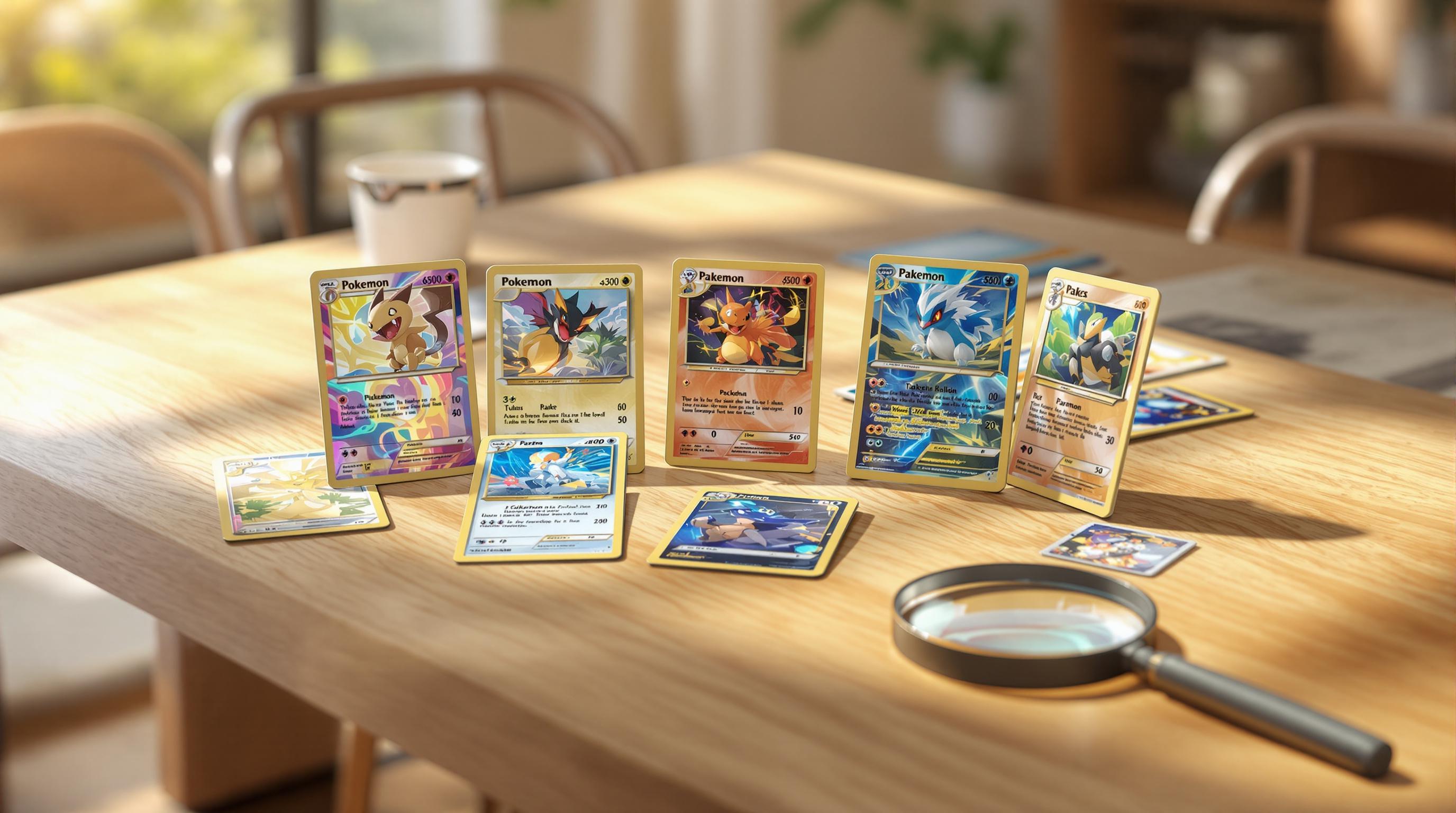When buying trading cards, timing is everything. Here’s how to make smarter purchases:
- Buy during off-peak times like after releases or during off-seasons to save money.
- Track price trends using tools to spot patterns and identify undervalued cards.
- Use local card shops for real-time insights, events, and hands-on evaluations.
- Avoid impulse buys by setting alerts, creating a budget, and planning purchases.
- Inspect card quality for authenticity and condition, especially for high-value cards.
- Watch for market drivers, like seasonal events, player performance, or reprints, which can impact prices.
Whether online or at local shops, understanding market trends and timing your purchases well can help you build a better collection and avoid overpaying.
How Do I Decide Which Cards To Buy?
Card Market Price Drivers
Understanding what drives card prices can help you make smarter buying decisions.
Season and Event Effects
Timing matters. Baseball card prices often rise during early-season training, mid-season breaks, or postseason events. For trading card games (TCGs), prices can jump around new set releases or major competitive events, like the Pokémon World Championships.
Supply and Availability
Card supply plays a big role in pricing:
- New Releases: Prices are usually highest right after a release due to strong demand and limited supply. Over time, they tend to stabilize.
- Limited Editions: Rare cards, like first edition Pokémon cards from the original base set, often hold higher value compared to more common versions.
- Reprints: Announcements of reprints can lower the value of original versions. However, cards protected from reprints - such as those on Magic: The Gathering's reserved list - are more likely to retain their value.
Market Influence Factors
Beyond availability, market trends and collector behavior can impact prices. Social media and collector sentiment are key drivers:
- Content Creator Effect: When popular YouTubers or streamers showcase specific cards, prices can spike almost instantly.
- Market Sentiment: Collector confidence plays a role. Established cards often remain stable even during uncertain times.
Local card shops can also be a great resource for spotting trends early. To find shops that specialize in your favorite cards, check out Card Shops List.
Keeping an eye on these factors can help you time your purchases for the best deals.
Best Times to Buy Cards
Researching Price Trends
Keeping an eye on historical price trends can help you make smarter buying decisions. By recognizing patterns in price movements, you can pinpoint the best times to purchase. Use trusted tools to track the price history of the cards you're interested in.
Here are some key areas to focus on:
- Look for seasonal price patterns in past data.
- Note how events or releases have influenced prices historically.
- Compare current prices to long-term averages to see if they're over- or under-valued.
This approach can help you better understand market trends and act at the right moment.
Basics of Market Timing
Timing is everything when it comes to buying cards. Pay attention to these key signals:
- Post-release adjustments: Card prices often spike right after release but tend to stabilize over time.
- Seasonal demand shifts: Sports cards, for example, typically drop in demand during off-seasons.
For additional insights, your local card shops can be a valuable resource. To find shops near you, check out Card Shops List.
sbb-itb-0db97a5
Buying Options: Online vs Local Shops
Choosing between online marketplaces and local card shops can impact both the value and overall experience of your card purchases. Each option has its own perks, depending on what you're looking for as a collector.
Store Type Comparison
Here’s a look at how online platforms stack up against local shops:
| Aspect | Online Marketplaces | Local Card Shops |
|---|---|---|
| Price Comparison | Easy to browse multiple sellers | Limited to the shop’s inventory |
| Card Inspection | Relies on photos and descriptions | Hands-on evaluation |
| Purchase Speed | Shipping delays (2–7 days) | Instant purchase |
| Selection Range | Wide variety across sellers | Curated, smaller inventory |
| Market Insight | Use of online price tracking tools | Advice from in-store experts |
| Community Access | Forums and online groups | Face-to-face connections |
| Additional Services | Professional grading often integrated | Events and in-person trades |
Online platforms give you access to a vast selection and tools for managing your collection. On the other hand, local shops provide personal advice and host events, creating a sense of community among collectors. These differences make local shops a valuable option, as explored further below.
Finding Local Card Shops
Finding a reliable local shop can elevate your collecting experience. Websites like Card Shops List offer directories of verified stores specializing in everything from sports cards to trading card games.
When evaluating local shops, keep these factors in mind:
- Services Offered: Look for shops that cover buying, selling, trading, and grading.
- Specialization: Some focus on specific cards, like Pokémon, sports cards, or Magic: The Gathering.
- Community Events: Check if they host gatherings, tournaments, or card breaks.
- Authentication: Ask about their grading and verification processes.
Many local shops now also have online stores, giving collectors the flexibility to shop however they prefer.
Common Buying Mistakes to Avoid
Steer clear of these common mistakes to get the most out of your card purchases.
Avoiding Impulse Purchases
Buying on impulse can lead to overspending and regret. To make better decisions, try these strategies:
| Strategy | How to Implement | Why It Helps |
|---|---|---|
| Set Price Alerts | Use price tracking tools to monitor card values | Helps you avoid buying during price spikes |
| Create Purchase Lists | Write down the cards you want and their target prices | Keeps you focused on your collecting goals |
| Cooling-off Period | Wait 48–72 hours before making big purchases | Reduces the chances of emotional decisions |
| Budget Planning | Set aside a monthly amount for card purchases | Prevents overspending and keeps finances in check |
Once you've avoided impulse buys, it's time to ensure you're getting quality cards for your money.
Checking Card Quality
Always inspect cards under bright light to spot issues like edge wear, corner damage, poor centering, or color problems. Look for signs of authenticity such as holograms, stock texture, print quality, and copyright marks. For high-value cards, professional grading services like PSA, BGS, or CGC can provide an extra layer of assurance.
Timing Your Purchases Around Events
Timing can make a big difference in the value you get. Plan your purchases around key events by researching card trends and targeting those with long-term potential. Buying during off-peak times - like after a release or following a tournament - can save you money. If you're visiting local card shops, take advantage of event specials, trade-in offers, or bundle deals. Be mindful of price corrections that often occur after big events.
Conclusion
Achieving success in card collecting often comes down to timing your purchases wisely. By understanding market trends and price changes, you can make smarter decisions that help you get the most out of your investments. Staying disciplined and connected to reliable sources and dealers is essential.
Local card shops can be a great resource - check out the Card Shops List to find specialized dealers who offer helpful market insights. Here's a quick summary of key strategies:
| Timing Factor | Strategy | Expected Outcome |
|---|---|---|
| Market Cycles | Analyze price trends and seasonal patterns | Identify better times to buy |
| Event Impact | Purchase during quieter periods post-releases | Save on acquisition costs |
| Shop Selection | Build relationships with trusted local dealers | Gain access to exclusive opportunities |
| Quality Control | Use professional grading for high-value cards | Safeguard your investment's worth |
FAQs
What’s the best way to track price trends and find undervalued trading cards?
To effectively track price trends and spot undervalued trading cards, start by monitoring online marketplaces, auction sites, and card forums where recent sales data is available. Pay attention to patterns in pricing over time, such as seasonal demand or spikes tied to events like tournaments or player performance.
You can also use price-tracking tools or apps designed for collectors to analyze historical data and identify cards that may be undervalued compared to their market potential. Staying informed about trends in the card-collecting community and understanding what drives value - such as rarity, condition, or popularity - can help you make smarter purchasing decisions.
What are the advantages of buying trading cards from local shops instead of online marketplaces?
Buying trading cards from local shops offers several unique benefits. First, you can inspect the cards in person, ensuring their condition meets your expectations before making a purchase. Second, local shops often foster a sense of community, allowing you to connect with other collectors, participate in events, or even trade cards directly.
Additionally, many shops provide expert advice and personalized recommendations, which can be especially helpful for new or seasoned collectors looking to expand their collections. Supporting local businesses also helps sustain the hobby within your area, ensuring these spaces remain available for future enthusiasts.
How do events like seasons or player performance impact trading card prices, and how can I make the most of it?
Trading card prices often fluctuate based on seasonal events and player performance. For example, a player’s standout game or championship win can cause their card values to spike, while off-seasons may lead to lower demand and prices. Similarly, seasonal trends, like holiday shopping or major tournaments, can also drive changes in card prices.
To take advantage of these trends, consider buying cards during the off-season when prices are typically lower, and selling when demand peaks, such as after a player’s big performance or during popular events. Staying informed about player stats and upcoming events can help you time your purchases and sales for maximum value.


